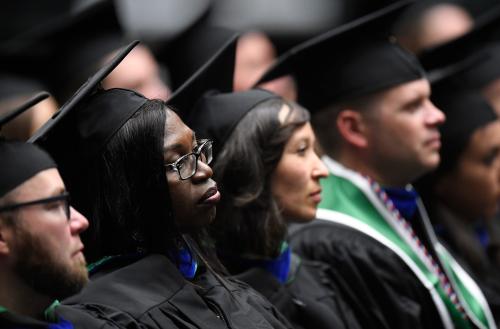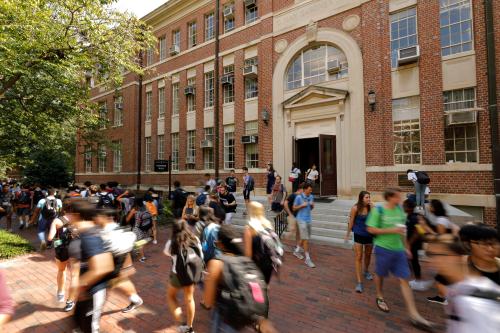In August the Biden administration announced that borrowers would be eligible for up to $10,000 in federal student loan forgiveness (up to $20,000 for those who ever received a Pell grant). Since widespread student loan forgiveness entered the political discourse, there have been fierce debates about the extent to which student loan debt is a policy problem that merits government intervention – and if so, the best solutions to pursue.
But in order to develop proposals to address future debt, we must first understand what drives cumulative and individual loan balances – and the consequences of that borrowing – for different postsecondary populations. While these discussions have often (rightfully) focused on undergraduate students, graduate students comprise an increasingly large share of student loan borrowers, meriting careful analysis of their enrollment and borrowing behaviors. In this post, I walk through graduate borrowing using a framework of considering excessive debt from both a borrowing and repayment angle to examine the extent to which there is a graduate loan problem to solve.
When is student loan debt a problem?
The federal student loan program was designed to support low- and middle-income families who could not afford the costs of a postsecondary education and would be unlikely to access loans on the private market. Borrowing opens the door to college for millions of students. But borrowing becomes troublesome if we believe an individual has over-borrowed – meaning any amount of debt that has not been sufficiently offset by higher earnings after graduation.
There are guardrails in place to prevent students from over-borrowing – such as federal loan limits – and to assist students after they have over-borrowed – such as loan forgiveness for graduates of predatory programs. Some of these safeguards protect all borrowers, but far fewer exist to guide prospective graduate students in deciding whether a postbaccalaureate degree will “pay off.”
Graduate debt on the rise
About half of federal student loan debt is held by individuals with a graduate degree – unsurprising since that calculation includes their undergraduate debt. Beyond their original undergraduate balances and additional graduate loans, graduate students also accumulate higher balances because of deferred repayment. While this policy enables graduate students to forego payments while they are in school, their undergraduate loan balances continue to accumulate interest and grow.
 Total graduate loan disbursements have also increased over time, particularly at private, non-profit institutions. As illustrated in Figure 1, during the 2012-13 academic year, U.S.-based higher education institutions disbursed a little over $7 billion in graduate PLUS loans; by 2019-20, that increased to $10 billion. Total direct unsubsidized loans to graduate students have remained fairly constant at around $26 billion each year, though there is considerable variation across institutions. For example, among the approximately 1,850 institutions disbursing a direct unsubsidized graduate loan in 2012-13, 42% disbursed more, 45% disbursed less, and 12% were disbursing no direct unsubsidized graduate loans by 2019-20.
Total graduate loan disbursements have also increased over time, particularly at private, non-profit institutions. As illustrated in Figure 1, during the 2012-13 academic year, U.S.-based higher education institutions disbursed a little over $7 billion in graduate PLUS loans; by 2019-20, that increased to $10 billion. Total direct unsubsidized loans to graduate students have remained fairly constant at around $26 billion each year, though there is considerable variation across institutions. For example, among the approximately 1,850 institutions disbursing a direct unsubsidized graduate loan in 2012-13, 42% disbursed more, 45% disbursed less, and 12% were disbursing no direct unsubsidized graduate loans by 2019-20.
Even if the cost of graduate school remained unchanged, an increase in the number of students going to graduate school would increase total and relative graduate loan debt. As of 2021, about 14% of the adult population held a postbaccalaureate degree, up from about 11% in 2011 and representing an additional 16.5 million advanced degree-holders. As Figure 2 shows, graduate completion has increased across many groups of U.S. students, ranging from white graduate completion increasing by about 26% to Black graduate completion increasing by 62%.
 Recent enrollment trends also suggest graduate students will likely comprise an even higher proportion of total borrowers in the coming years as undergraduate enrollment declined throughout the COVID-19 pandemic while graduate enrollment increased.
Recent enrollment trends also suggest graduate students will likely comprise an even higher proportion of total borrowers in the coming years as undergraduate enrollment declined throughout the COVID-19 pandemic while graduate enrollment increased.
More students enrolling in graduate school
Why are more students enrolling in graduate school? Students might enroll due to labor market demands. The share of jobs that require or substantially reward graduate training has increased over time, with one analysis finding that the share of STEM jobs that most typically require a master’s or professional degree increased by 5.7% between 2004 and 2015.
Even if a profession does not explicitly require a graduate degree, occupational norms and salary incentives can drive individuals to pursue more education. For example, while few states explicitly require teachers to hold a master’s degree, in practice the share of teachers with a postbaccalaureate degree increased from 47% in 2000 to 58% in 2018, likely because 88% of the largest school districts provide salary increases to teachers who earn a master’s degree, incentivizing teachers to invest in additional education.
Even absent occupational requirements or incentives, some individuals may pursue a graduate degree hoping to overcome persistent pay disparities. Among fully employed bachelor’s degree holders, Black workers make about $4,200 less and Hispanic workers make about $5,300 less each year than white workers. Earning an additional credential is one way that workers might attempt to reduce these pay disparities.
Increasing costs of graduate school
While graduate enrollment has increased, that doesn’t necessarily mean individual students face a higher debt burden, even if graduate students as a whole hold a larger relative share of debt. To what extent do higher graduate loan balances reflect increased individual borrowing?
 Graduate tuition and fees have increased somewhat, as illustrated (using non-adjusted prices) in Figure 3, though more as a gradual trend than in a sharp or direct response to federal loan policy. But receiving less attention are increases in living expenses, which contribute a meaningful share of the costs graduate students face during enrollment. Graduate students face the same reality of inflation as other individuals, but at a period of life when they are enrolled in school and often pausing their employment and earnings. And there are typically fewer institutional subsidies in place to alleviate those costs – for example, while undergraduates living on campus typically pay less than market rates for rent, it is less common for graduate students to have access to university-subsidized housing.
Graduate tuition and fees have increased somewhat, as illustrated (using non-adjusted prices) in Figure 3, though more as a gradual trend than in a sharp or direct response to federal loan policy. But receiving less attention are increases in living expenses, which contribute a meaningful share of the costs graduate students face during enrollment. Graduate students face the same reality of inflation as other individuals, but at a period of life when they are enrolled in school and often pausing their employment and earnings. And there are typically fewer institutional subsidies in place to alleviate those costs – for example, while undergraduates living on campus typically pay less than market rates for rent, it is less common for graduate students to have access to university-subsidized housing.
Graduate students also often have children or other dependents they are supporting while enrolled. As the costs of raising a family have increased, current graduate students face a higher cost of living than previous cohorts (of course an increasing share of undergraduate students are also parents and face similar challenges supporting their family).
The consequences of graduate school debt
Graduate debt has increased, in a national sense and for individual students as more students are enrolling in graduate school and the direct and indirect costs of graduate school have become more expensive. But is this a problem? The answer hinges on the returns to graduate school – are students financially better off after their graduate degree, do they have the means to repay their debts, and are they able to pursue a more meaningful career and lifestyle?
On average, students earn more after completing a graduate degree. But that average masks considerable variation across fields. Recent research by Veronica Minaya, Judith Scott-Clayton, and Rachel Yang Zhou finds the returns to a Health graduate degree are nearly double that of a graduate degree in Engineering and virtually no wage return to a graduate degree in the Arts. The authors also find that the wage increase from a graduate degree has been lower following the Great Recession than among earlier cohorts, and that Black graduate degree recipients experience a lower income increase. Black workers also graduate from college with higher debt and that debt gap triples within four years of earning their BA (partially due to higher rates of graduate school enrollment), and therefore must allocate a higher share of this income increase toward repayment.
With these trends, we might expect higher incidents of repayment struggles among graduate borrowers. To be sure, graduate debt holders are among the least likely borrowers to default on their loans, but graduate default rates have increased in recent years. Further, default is but one extreme measure of repayment difficulties. Research shows that students with higher student loan debt (with “high balance” holders often serving as a proxy for graduate school enrollment given undergraduate loan limits) are less likely to pursue public service careers and delay homeownership.
Considering solutions
While individuals disagree on the policy solutions to reform the student loan system, there is near universal agreement that the current approach does not work. There may not be a crisis (yet) around graduate school repayment, and many individuals benefit significantly from attending graduate school. But rising costs, troubling trends in default rates, and disparate returns by student race and field of study indicate that more support is needed to ensure students are not over-borrowing and are instead enrolling in programs where the returns will offset their borrowing and lead to a meaningful improvement in their quality of life.
For all prospective students, these solutions should address each stage of the decision-making process. At a minimum, students need realistic information about anticipated earnings boosts from different programs. Beyond that initial enrollment decision, policies should consider how to provide alternative support to loans (which might include grant aid or policies that target the costs of enrollment), how to help students critically examine how much to borrow rather than defaulting to the maximum award, and how to support students with repayment over the course of their careers.
Determining exactly what those solutions are requires a nuanced understanding of the different costs and challenges faced by different postsecondary populations, from prospective sub baccalaureate to postbaccalaureate students, and tailored policies to address those unique needs.







Commentary
The causes and consequences of graduate school debt
October 4, 2022
In August the Biden administration announced that borrowers would be eligible for up to $10,000 in federal student loan forgiveness (up to $20,000 for those who ever received a Pell grant). Since widespread student loan forgiveness entered the political discourse, there have been fierce debates about the extent to which student loan debt is a policy problem that merits government intervention – and if so, the best solutions to pursue.